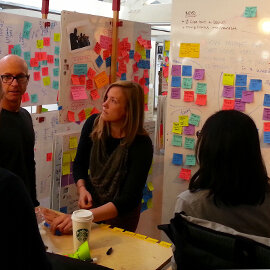Designing for People, Not Programs
Well-developed plans to work together to help people in need are often more about the system than the people, and therefore can frustrate the people involved, or simply fail to achieve meaningful goals. Human centered design is one helpful tool to move from focusing on programs to people.
Programs to people
A colleague of mine was leading a focus group with low-income, single mothers in California, working to understand what they want for their children. The early childhood system is designed around a few key metrics, but often comes down to school readiness. Will children be able to get to 3rd grade and achieve high reading scores? If so, we have confidence that they’ll be more successful in life. But what he found was that these mothers didn’t talk about kindergarten readiness as a goal for their children. They were not thinking about 3rd-grade reading scores. They talked about wanting their children to grow up to be good people. And they wanted to know how the early childhood programs could help.
There was a disconnect between what leaders in the system said they wanted for families and what families wanted themselves. One consequence of this reality in early childhood work, is that it is often challenging to get parents engaged in programs. Not because the parents don’t care, but because there is a disconnect between the purpose of the program and the purpose of the people. The goals aren’t mutually exclusive, but with limited time and attention, they need to be aligned.
We can learn from this experiences as we approach the question of how to engage communities to reduce firearm suicide in Missouri. Rather than start by casting a big vision for changing the system and inviting participation in our program, we should start by listening to the communities and partners we seek to serve. If we have a better sense of what they care about and what their day-to-day work looks like, we can design programs and messaging to be more motivating, sustainable, and effective.
The tools of human centered design can help us do this work well. Haley Robison Dake, an design expert trained at the Stanford d.school, led our Firearm Suicide Prevention cohort in a short workshop introducing two key principles of the human centered design approach:
1. Redefine every problem from the perspective of the people
2. Test ideas in minutes, not months
Building empathy
The first step to seeing a problem from a people perspective is to conduct empathy interviews – or more simply – to have a regular, open, curious conversations in which you seek to set assumptions aside in order to understand another person’s experience and what they genuinely care about. This is challenging work. It’s not something most of us do most of the time. It’s not something our systems demand of us, to know people and build relationships, especially with people we may disagree with. But we believe these are the foundations of building lasting change.
While no technique can replace genuine human respect and interest, Haley provided a succinct set of tips for leading interviews that will generate meaningful insights:
Come prepared with questions. Start general and then specific.
Ask open-ended questions instead of yes-or-no questions.
Take notes on exactly what they say – not what you think they are saying.
Listen for emotion, surprising insights, and specific stories.
Observe body language and surroundings; take pictures if allowed.
After the interview, she proposed reflecting on your experience by asking:
What was I surprised to notice? Where were there tensions, contradictions,
or points of real resonance?What do I think this experience means? What do I infer?
How might we restate our challenge so that it would immediately resonate with this person?
By redefining the challenge from the perspective of the person we are with, we begin to imagine and generate more motivating, and ultimately more impactful, ideas for designing our programs.
Consequential feedback loops
As a team, and organization, develops the skills and practice of conducting empathy interviews, collective personal insights become a “data”-base for developing “data”-driven programs. With better human data in hand, new hypothesis for engagement emerge that we can test in the context of these same relationships.
Our hope is that by taking this first step of integrating consistent listening and relationship building before our programs are designed, and as they are developed, our collective efforts to address the complex challenge of firearm suicide across Missouri will generate more lasting change.
